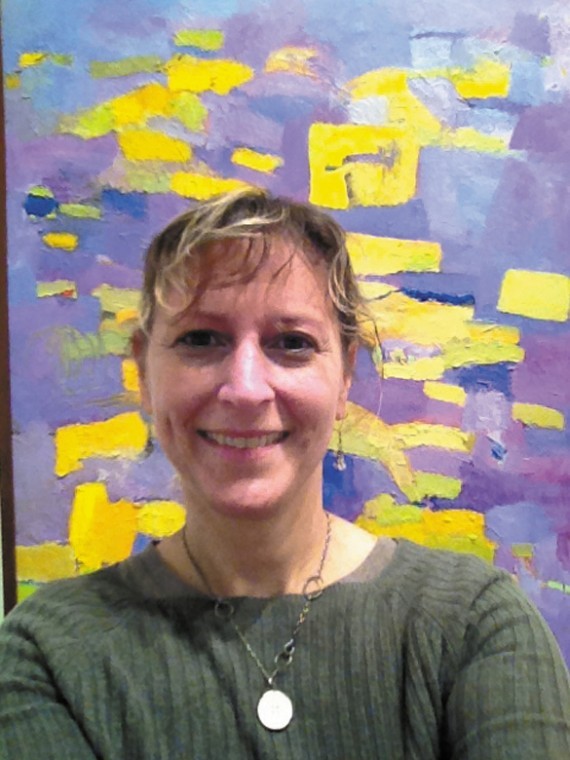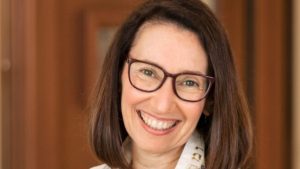Art St. Louis director believes in local artists, ‘vitality’ of downtown
Published December 7, 2011
Robin Hirsch is an artist in her own right, having earned a bachelor’s in fine arts in photography from the Kansas City Art Institute in 1985. When pressed about how she expresses her artistic passion these days, she points to the paintings and multimedia objects all around her in the first floor gallery of the historic 555 Washington Avenue building that’s the home of Art St. Louis (www.artstlouis.org). She is gallery director and associate director of the organization.
Hirsch, 48 and single, is a resident of Webster Groves. She grew up attending Temple Israel and attends High Holiday services at Neve Shalom. She has long been a juror for art exhibits, lending her critical eye to shows as far away as Oshkosh, Wis.; Springfield, Ill.; Rolla, Sedalia and Columbia, all in Missouri, as well as many in the St. Louis area.
ADVERTISEMENT
We spoke last week at the Art St. Louis’ gallery, which is about 5,000 square feet. She was dressed in a wrap-around print skirt and a grey cotton sweater and wearing her favorite brown Rocket Dog cowboy boots.
How long have you been with Art St. Louis and where did you go to high school?
Most of my adult life, 23 years. I went to Parkway Central.
Why Neve Shalom?
It’s awesome. You never know what it’s going to be, but it’s always exactly what it needs to be.
Tell me about Art St. Louis.
I spend my time running this organization. It was founded by a group of artists in 1977. Before we were Art St. Louis, we were officially called St. Louis Artists Coalition, which is what it was when I started.
What was the purpose?
In the early 1980s, there were a lot of commercial galleries showing high-end nationally and internationally known artists. There was no place for St. Louis regional artists to show their work, to provide a resource for exhibitions and other programming that highlights St. Louis regional artists. Our region includes a 200-mile radius.
Who comes here?
On a given day, we can have anywhere from 10 to 20 to 50 people. It differs from day to day. We work to get all the artists in the show to say, hey, tell your people, anyone you know, to come down to the gallery.
Do you have a sense of downtown’s future?
ADVERTISEMENT
I’ve worked downtown 23 years in four different locations. We were there as all the businesses and people moved away from downtown and totally migrated west. Everybody either went out of business or moved west. At the St. Louis Design Center at 917 Locust, I could see the Merchandise Mart annex building from my office window, watching as homeless people would crawl in and out one of the building’s open windows. All this resurgence today, especially compared to 15 and 30 years ago. There’s a vibrancy coming back. It takes 10 years for something to come back downtown.
Do you feel safe here? People just walk in. Does that ever worry you?
Yes and no. I’ve worked downtown long enough to know that if someone’s going to do harm, they are going to find a way to do it. I try to take as many precautions as possible. I’ve got people who walk in the door every day who are shady characters and just want to use the bathroom.
How does Judaism affect what you do?
It’s who I am. It’s how I associate what I am as a person in the wide world at large. The tenets of the belief system guide my daily life.
Can you explain that a little better?
I don’t think I have words for it. My grandmother was raised like the Israeli people I know. They identify with being a Jew, but there’s no religion. My grandparents, who were first generation, came from those villages in Russia that no longer exist. The people from all of those towns gathered in Philadelphia. They had the holiday meals, but they never had any kind of religion included.
Maybe they felt their religion was very painful for them.
Yeah. My grandmother, who’s 97, says she’s Jewish, but I don’t think she has the religious quality. But she has the whole cultural thing, which is sometimes hard to explain to people who aren’t part of that culture. I think you are either spiritual or you aren’t. I am spoiled, having been raised in it. But I am completely naïve about it. There is so much I’d like to learn.
Can you characterize what’s going on in St. Louis with artists?
They are doing everything. There’s definitely not a regional style. You can see that in this show (Art St Louis XXVII, the Exhibition). It’s all styles, all media, all themes. There are 60 different artists in this show. There were 500 pieces submitted, from which our juror selected 70. This is representative of what people in St. Louis are doing who are trying to get their works seen and shown. There are tens of thousands of people making art in their studios, their homes, wherever, in their jobs, where they are not showing it to the rest of the community.
Because they don’t want to show their work?
There are people whose art is their passion, and they don’t need to have the approval or have other people see it, which is great. They are doing everything. The only thing limiting artists these days is the economy. People who are photographic artists are not printing larger pieces any more. The framing and all of that costs a lot of money.
What can you tell about the time we live in St. Louis by looking at this art?
A year after 9/11, we had a tribute exhibition. There were a lot of hot topics there. Then a couple of years later, we had an exhibit about sex, politics and war. For the most part, it’s not a lot of reactionary work. There is a lot of abstract work in St. Louis, and there’s a lot of literal portraits and table tops and landscapes.
What do you mean by reactionary art work?
Reacting to the times, to war, politics. You would think that because times are so tough and politics are such a major part of our lives-you know, wars are going on in our times-that would be reflected in art, but it’s not as much in the regional artists who are out there entering competitions and showing. I know they are making it, but they aren’t showing it as often.
















